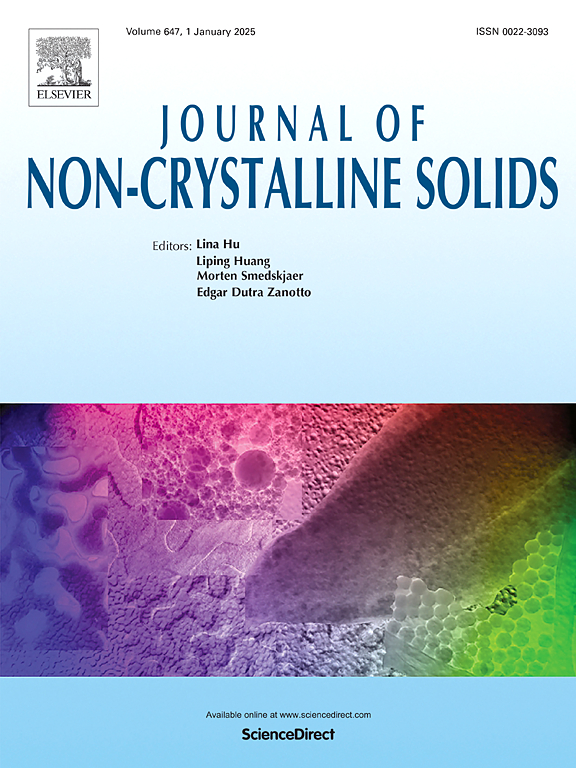Tailoring magnetic properties of Fe74B20Nb2Hf2Si2 soft magnetic amorphous alloy: Insights into partial annealing and crystallization
IF 3.5
3区 材料科学
Q1 MATERIALS SCIENCE, CERAMICS
引用次数: 0
Abstract
This study investigates the structural and magnetic evolution of Fe74B20Nb2Hf2Si2 amorphous alloy across the as-cast state and three distinct crystallization stages. Mössbauer spectroscopy of the as-cast state revealed ferromagnetic amorphous phases characterized by broad, asymmetric spectral lines and hyperfine magnetic field distribution peaks in the 5–30 T range, with an average hyperfine field (P(Bhf)avg) of 19.9 T, lower than Fe80B20 (28.2 T) and FINEMET (22.8 T). It indicated that the magnetic ordering stabilized can be reduced by Nb and Hf through increased atomic spacing and structural disorder. Annealing promotes the formation of nanocrystalline phases such as α-Fe, Fe2B, Fe23B6, and Fe2(Hf, Nb), with P(Bhf)avg increasing to 29.9 T in the third stage, reflecting enhanced magnetic ordering due to the growth of α-Fe. Simultaneously, saturation magnetization (Ms) increased from 1.14 to 1.71 T, while coercivity (Hc) increased from 1.5 to 40 A/m owing to phase boundaries and domain wall pinning. The exchange stiffness (Aex) and spin-wave stiffness (Dsp) also increase, indicating stronger ferromagnetic coupling. Alongside, the total magnetic loss (P) increases significantly during crystallization due to domain wall pinning and a decrease in electrical resistivity. The Curie temperature (Tc) elevates from 622 to 653 K, attributed to Fe depletion and B and Si enrichment, intensifying Fe–Fe exchange interactions. Overall, the alloy exhibits superior magnetic properties (such as high Ms, Aex, and permeability) during the crystallization process. Therefore, this alloy can be a promising candidate for high-frequency magnetic applications.
Fe74B20Nb2Hf2Si2软磁非晶合金的定制磁性:部分退火和结晶研究
本文研究了Fe74B20Nb2Hf2Si2非晶合金在铸态和三个不同结晶阶段的组织和磁性演变。在铸态Mössbauer谱图上发现了铁磁性非晶相,谱线宽且不对称,在5 ~ 30 T范围内有超细磁场分布峰,平均超细场(P(Bhf)avg)为19.9 T,低于Fe80B20 (28.2 T)和FINEMET (22.8 T)。结果表明,Nb和Hf可以通过增加原子间距和结构无序性来降低磁性有序稳定性。退火促进了α-Fe、Fe2B、Fe23B6和Fe2(Hf, Nb)等纳米晶相的形成,第三阶段P(Bhf)平均值增加到29.9 T,反映了α-Fe的生长增强了磁性有序性。同时,饱和磁化强度(Ms)由1.14 T增加到1.71 T,矫顽力(Hc)由1.5 A/m增加到40 A/m。交换刚度(Aex)和自旋波刚度(Dsp)也增加,表明铁磁耦合增强。在结晶过程中,由于畴壁钉住和电阻率的降低,总磁损失(P)显著增加。居里温度(Tc)由622 K升高到653 K,主要是由于Fe的损耗和B、Si的富集,Fe - Fe交换作用增强。总体而言,合金在结晶过程中表现出优异的磁性能(如高Ms, Aex和磁导率)。因此,这种合金可以成为高频磁性应用的有希望的候选者。
本文章由计算机程序翻译,如有差异,请以英文原文为准。
求助全文
约1分钟内获得全文
求助全文
来源期刊

Journal of Non-crystalline Solids
工程技术-材料科学:硅酸盐
CiteScore
6.50
自引率
11.40%
发文量
576
审稿时长
35 days
期刊介绍:
The Journal of Non-Crystalline Solids publishes review articles, research papers, and Letters to the Editor on amorphous and glassy materials, including inorganic, organic, polymeric, hybrid and metallic systems. Papers on partially glassy materials, such as glass-ceramics and glass-matrix composites, and papers involving the liquid state are also included in so far as the properties of the liquid are relevant for the formation of the solid.
In all cases the papers must demonstrate both novelty and importance to the field, by way of significant advances in understanding or application of non-crystalline solids; in the case of Letters, a compelling case must also be made for expedited handling.
 求助内容:
求助内容: 应助结果提醒方式:
应助结果提醒方式:


